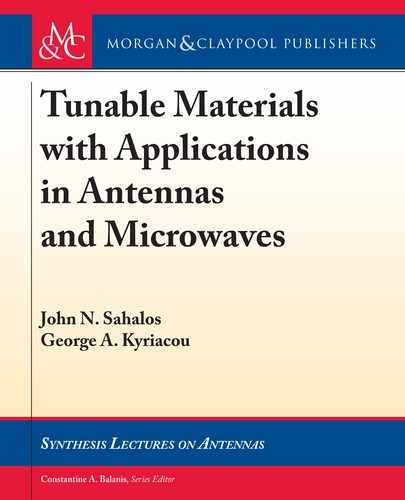
3.12. SPIN–WAVES ACCOUNTING FOR DIPOLE–DIPOLE INTERACTION 91
Formation of domain walls: Besides demagnetization, exchange-energy minimization
strives to align all spins or keep magnetization uniform, acting in the same direction as volume-
pole avoidance and contrary to surface-poles avoidance. is contradiction becomes stronger in
the neighborhood of the specimen’s surface. e overall energy minimization compromise yields
the division into chunks, which are domains with uniform magnetization and different direction,
in each domain. us, energy is minimized within each domain. Moreover, energy between
domains is also minimized by forming flux loops, as shown in Figure 3.6 [24].
M
Figure 3.6: e formation of domains minimizes exchange and demagnetization energy [24].
However, the formation of domain walls causes an increase in exchange energy. eir final
formation depends on whether this energy increase is lower than the corresponding reduction
in demagnetization energy. Furthermore, a finite length is required for the change of the direc-
tion of magnetization between neighboring domains. For a very small specimen, the increase
in energy for the formation of domain walls may be quite higher than the reduction in demag-
netization energy. is results in a single domain or a vortex state as shown in Figure 3.7 [24].
For ferrimagnetic films, the primary effect of the demagnetizing field is to make the direction of
magnetization point parallel to the plane of the film because of surface poles. However, demag-
netization due to surface poles may be ignored in the interior of the film. Even though there are
long-range effects, they do decay with distance, eventually becoming negligible [24].
M
Figure 3.7: Single domain or a vortex state in very small specimens [24].
Returning to low-order spin waves, their wavelength is usually large enough to ignore
surface-pole demagnetization effects, but pole volumes must be considered. is is usually
termed “dipole-dipole interaction.”
3.12 SPIN–WAVES ACCOUNTING FOR DIPOLE–DIPOLE
INTERACTION
Considering only the volume poles r
N
M and ignoring the surface poles (to be accounted for
magnetostatic modes), the dipole-dipole interaction field .
N
H
d
/ can be evaluated from Eq. (3.34).

92 3. FINITE FERRITE SAMPLES
Assuming a plane-wave spin-mode magnetization of the form of (3.28), the dipolar field
reads [25–28]:
N
H
dip;k
D
N
H
d0
e
j
N
kNr
e
j!t
; (3.39a)
with
N
H
d 0
D
N
k Nm
k
N
k
k
2
: (3.39b)
Equations (3.39) constitute an important step in the analysis since they provide us with a
field distribution all over the sample. However, they are only valid for the assumption of plane
waves. Note that the difference of (3.39) from the corresponding references is due to the use
herein of the SI system of units instead of the CGS. In addition, Nm
k
is transverse to
N
M
s
since any
small signal component along the DC bias direction has no effect at all. e dipolar magnetic
field of (3.39) should now be included in the LLG equation (3.23) through
N
H
m
as:
N
H
m
D
N
H
anis
C
N
H
ex
C
N
H
dip
: (3.40)
Since
N
H
dip
, like
N
H
ex
, is proportional to M , it seems possible to handle the solution of the
LLG equation by adding terms to some equivalent ŒN
eq
factors. In such a case, the magnetic
susceptibility may once again be obtained from (3.9) and the spin-wave resonance frequency
from (3.11). However, there is an additional difficulty in this case. A closer observation of (3.39)
reveals that
N
H
dip;k
can be related to Nm
k
only through a tensor ŒN
eq
. As in the previous case, the
ferrite will be assumed to be magnetized in the z-direction, namely:
N
H
DC
D H
0
Oz;
N
M
s
D M
s
Oz; Nm
k
D
m
kx
; m
ky
; 0
T
and
N
M D
m
kx
; m
ky
; M
s
T
:
(3.41)
erefore, the Oz-related ŒN
eq
factors will be set equal to zero. Starting from (3.39), this
can be written as:
N
H
d
D Ox
k
2
x
k
2
m
kx
C
k
x
k
y
k
2
m
ky
Oy
k
x
k
y
k
2
m
kx
C
k
2
y
k
2
m
ky
!
or
"
H
dx
H
dy
#
D
"
N
d
xx
N
d
xy
N
d
yx
N
d
yy
# "
m
kx
m
ky
#
:
(3.42)
For convenience, let us first ignore H
anis
, which at any time can be added to the external
biasing field H
0
by a modification of !
0
as in (3.31). Also, remember that losses can always be
included by making !
0
complex. In turn, the tensor ŒN
eq
will describe the exchange
N
H
e
and
the dipolar fields, to which the former contributes only its main diagonal. Rewriting (3.10) for
this case, we have:
N
M D ŒX
N
H
e
ŒX ŒN
eq
N
M ; (3.43)

3.12. SPIN–WAVES ACCOUNTING FOR DIPOLE–DIPOLE INTERACTION 93
where ŒX is:
ŒX D
2
6
4
X
xx
X
xy
0
X
yx
X
yy
0
0 0 0
3
7
5
and
X
xx
D X
yy
D
!
0
!
m
!
2
0
!
2
X
xy
D X
yx
D
j!!
m
!
2
0
!
2
:
(3.44)
Likewise, the equivalent N -factors read as follows:
ŒN
eq
D
2
6
4
N
xx
N
xy
0
N
yx
N
yy
0
0 0 0
3
7
5
;
N
xx
D
Dk
2
=M
s
C
k
2
x
=k
2
N
yy
D
Dk
2
=M
s
C
k
2
y
=k
2
N
xy
D N
yx
D k
x
k
y
=k
2
:
(3.45)
It is worth solving (3.43) for the common small signal approximation in its more general
form. en, it can be simplified by substituting (3.44) and (3.45) since this does not involve
any extreme complexity. For this purpose, we lay (3.43) as a linear system for
N
M -components as
unknowns to be solved in terms of
N
H
e
-components. After some algebra, we end up with:
M
x
D
1
˚
X
xx
C N
yy
X
H
xe
C
X
xy
N
xy
X
H
ye
(3.46a)
M
y
D
1
˚
X
yx
N
yx
X
H
xe
C
X
yy
C N
xx
X
H
ye
(3.46b)
D 1 CN
xx
X
xx
C N
yy
X
yy
C N
xy
X
yx
C N
yx
X
xy
C N
X
; where (3.46c)
X
D X
xx
X
yy
X
xy
X
yx
and N
D N
xx
N
yy
N
xy
N
yx
: (3.46d)
Note that expressions (3.46) reduce exactly to that of (3.11) when N
xy
D N
yx
D 0. More-
over, (3.46) can be considered for the definition of a more general susceptibility tensor. e most
interesting part of (3.46c) is the spin-wave resonant frequency, which is given by setting D 0.
Exploiting (3.44), this reads:
D 1 CX
xx
N
xx
C N
yy
C X
xy
N
yx
N
xy
C N
X
; (3.47)
where
X
is simplified to:
X
D !
2
m
=
!
2
0
!
2
: (3.48)
Substituting to (3.45) we have:
N
xx
C N
yy
D 2
Dk
2
M
s
C sin
2
k
(3.49a)
N
D
Dk
2
M
s
Dk
2
M
s
C sin
2
k
; (3.49b)
..................Content has been hidden....................
You can't read the all page of ebook, please click here login for view all page.
